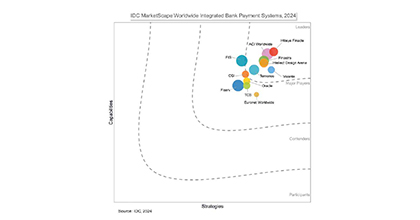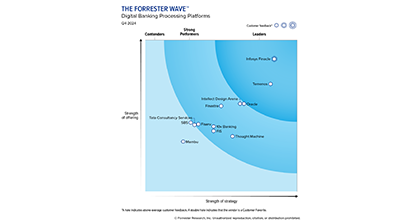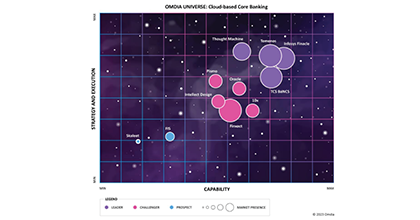-
![]() Quantum Computing: As the Future Awaits, The Strides Are DefinitiveQuantum computing is no longer confined to theory or the edges of experimental science - it is rapidly advancing toward practical impact.Read More
Quantum Computing: As the Future Awaits, The Strides Are DefinitiveQuantum computing is no longer confined to theory or the edges of experimental science - it is rapidly advancing toward practical impact.Read More -
![IDC IDC]() IDC MarketScape: Worldwide Integrated Bank PaymentFinacle Payments is an enterprise payments services system that manages end-to-end payments across instrument types, payment schemes, transaction types, customeRead More
IDC MarketScape: Worldwide Integrated Bank PaymentFinacle Payments is an enterprise payments services system that manages end-to-end payments across instrument types, payment schemes, transaction types, customeRead More -
![]() Supply Chain FinanceToday, as businesses seek to make their ecosystems more resilient, Supply Chain Finance (SCF) has emerged as a powerful lever for banks and financial institutions to support clients, while unlocking new revenue streams.Read More
Supply Chain FinanceToday, as businesses seek to make their ecosystems more resilient, Supply Chain Finance (SCF) has emerged as a powerful lever for banks and financial institutions to support clients, while unlocking new revenue streams.Read More
-
![]() The Future of Core Banking: Business and Technology EvolutionOur point of view paper, “The Future of Core Banking: Business and Technology Evolution”, serves as a candid and forward-looking benchmark of your institution’s readiness—and a strategic playbook for core modernization.Read More
The Future of Core Banking: Business and Technology EvolutionOur point of view paper, “The Future of Core Banking: Business and Technology Evolution”, serves as a candid and forward-looking benchmark of your institution’s readiness—and a strategic playbook for core modernization.Read More -
![The Forrester Wave The Forrester Wave]() Forrester Wave Digital Banking, Q4 2024Finacle is best suited for large retail, SMB, and corporate banks who seek a modern, comprehensive, innovative platform with superior support.Read More
Forrester Wave Digital Banking, Q4 2024Finacle is best suited for large retail, SMB, and corporate banks who seek a modern, comprehensive, innovative platform with superior support.Read More -
![]() Driving Comprehensive Revenue ManagementDiscover why revenue management must evolve into a comprehensive, strategic capability. Decode a blueprint to overcome challenges and unlock sustainable monetization.Read More
Driving Comprehensive Revenue ManagementDiscover why revenue management must evolve into a comprehensive, strategic capability. Decode a blueprint to overcome challenges and unlock sustainable monetization.Read More
-
![]() Shaping Banking’s Next: Banking Technology Trends for 2025 and BeyondThe banking industry has been balancing disruption and opportunity for several years now, and the pace of change shows no signs of slowing as we move into 2025 and beyond.Read More
Shaping Banking’s Next: Banking Technology Trends for 2025 and BeyondThe banking industry has been balancing disruption and opportunity for several years now, and the pace of change shows no signs of slowing as we move into 2025 and beyond.Read More -
![]() Virtual Accounts 2.0: Surpass Conventional Cash Management and Unlock Next-Gen PossibilitiesVirtual Account Management was a groundbreaking shift in the banking landscape, revolutionising use cases like cash concentration, pooling, centralised treasury management, and in-house banking (POBO, ROBO, COBO)Read More
Virtual Accounts 2.0: Surpass Conventional Cash Management and Unlock Next-Gen PossibilitiesVirtual Account Management was a groundbreaking shift in the banking landscape, revolutionising use cases like cash concentration, pooling, centralised treasury management, and in-house banking (POBO, ROBO, COBO)Read More -
![]() Unlocking Hybrid CloudAs banks push forward with their digital transformation agenda, cloud serves as a pivotal enabler. Each bank, at varying stages of adoption, crafts its unique path, dictated by context, regulations, and risk appetite.Read More
Unlocking Hybrid CloudAs banks push forward with their digital transformation agenda, cloud serves as a pivotal enabler. Each bank, at varying stages of adoption, crafts its unique path, dictated by context, regulations, and risk appetite.Read More
-
![]() Banking on CloudThis report from Infosys Finacle delves into the need for accelerating cloud adoption, highlights the current state of the industry, and puts forth key recommenRead More
Banking on CloudThis report from Infosys Finacle delves into the need for accelerating cloud adoption, highlights the current state of the industry, and puts forth key recommenRead More -
![]() Omdia Universe | Cloud-based Core BankingIn the report, Omdia highlights the following key capabilities of leading cloud-based core banking providers:Read more
Omdia Universe | Cloud-based Core BankingIn the report, Omdia highlights the following key capabilities of leading cloud-based core banking providers:Read more
-
![]() Emirates NBDEmirates NBD consolidates its operations on a single version for scalability, agility, and standardization.Read More
Emirates NBDEmirates NBD consolidates its operations on a single version for scalability, agility, and standardization.Read More -
![]() A Global Top 5 BankDiscover how a global top 5 bank headquartered in the US accelerated payments transformation.Read More
A Global Top 5 BankDiscover how a global top 5 bank headquartered in the US accelerated payments transformation.Read More -
![]() Union Bank of IndiaUnion Bank of India launches Union Virtual Connect (UVConn) by leveraging WhatsApp to provide customers personalized banking services.Read More
Union Bank of IndiaUnion Bank of India launches Union Virtual Connect (UVConn) by leveraging WhatsApp to provide customers personalized banking services.Read More

Navigating Regulatory & Geopolitical Shifts in Payments
Blogs
As digital payments gain traction, the financial sector is embracing innovative technology and open architectures to meet rising consumer expectations In the financial sector, particularly in payments, change is imminent. The disruption is caused by several factors, which are gaining enough traction in banks to modernise their payment systems.
The rise of a cashless economy is one of them. Rather than relying on currency, nations worldwide are vying to go cashless. For instance, several European countries are setting the bar for the transition to entirely digital transactions.
This rise in online and digital payments is the result of rapid urbanisation and technical development, which is exemplified by the widespread use of mobile devices and smart apps.
The Impact of Changing Consumer Preferences on Payment Methods
As payments grow more digital and real-time, cash is being replaced by cards, e-wallets, tap-to-pay, or mobile-based solutions.
Fintech companies are quickly introducing cutting-edge payment products thanks to their expertise in digital technology and unique business strategies. Large tech firms with billions of customers worldwide also disrupt the payments environment, creating a highly competitive market.
These changes result from shifting consumer tastes and expectations for payments, which are leaning increasingly towards quick, seamless and contactless transactions.
Geopolitical Power Shifts and Their Impact on Digital Payments
Studies predict that by 2025 more than half of the world’s population will reportedly use mobile wallets. The millennial generation, which epitomises this digital lifestyle and expects seamless and continuous financial transactions, has considerably impacted this trend. Those dissatisfied will likely go to another bank that can onboard them quickly and easily.
Large corporations are also increasingly digitising their operations, adopting digital commerce, and making themselves available for online transactions. Digital payments are part of their business model, from payment gateways to structured, time-bound payments and collections. Consequently, by 2027, the value of transactions in the worldwide digital commerce sector will be predicted to exceed $8.9 trillion.
The environment of digital payments is also changing due to the change in geopolitical power. There is a definite shift from partnerships to provide seamless payment corridors and transfer mechanisms towards country-specific silos. SEPA, Immediate, and P27, which aim to create a seamless payments infrastructure throughout the Nordic area, are three examples of these new digital payment proposals.
To decrease risks, improve security, and standardise through an industry-wide transition to ISO 20022, regulatory organisations and industry leaders are pushing modernisation through various efforts. Future digital payments may already be seen as a result of the rising popularity of digital currencies.
According to reports, 86% of central banks are thinking about adopting central bank digital currencies (CBDC). While the Eurozone and the UK are currently doing research, Sweden and Norway are already testing CBDC prototypes.
Lastly, new technology – such as cloud computing, open APIs and distributed ledger technology – lays the groundwork for innovative payment business models and accelerates cashless transactions.
Embracing Open Architecture Through APIs and Payment Ecosystems
Banks must redesign their payment roadmap and provide the proper technological foundations to succeed in the digital economy. These foundations should have the following:
- Many APIs fuel an open architecture that encourages participation in an open payment ecosystem and drives innovation.
- As more areas and nations promote digital initiatives, the need for a population-size payment processing engine will increase; as a result, the volume of digital payments will only increase exponentially.
- The capacity to process payments from various business divisions, including retail, corporate, private banking, and wealth management, with ease while supporting the whole payments lifecycle. A single payment hub must serve the needs of the entire company.
- Real-time rails for accelerating adoption and enabling comprehensive real-time processing with seamless communication. Although digital offers vary by location, they are all designed to process payments instantly, quickly, and in real-time. So, the bank’s solution must guarantee that all transactions are handled immediately and that settlements move forward with this goal in mind.
- With a cloud-native and innovation-focused strategy, banks can analyse data and gain real-time insights to understand their customers better and integrate innovation across their banking experiences.
Banks can better regulate their payments business on several fronts using a payment technology foundation created with the factors mentioned earlier. In this highly regulated industry, it will help manage the time and costs of compliance while enabling seamless consumer experiences. Also, banks can scale more effectively and innovate more quickly, participating in the growing real-time payments ecosystem due to improved procedures and automation.
This future will be possible at cheaper maintenance costs for the technology used. It will give banks a solid foundation to explore possibilities where their products are seamlessly integrated into the customer’s main journey.
This article was previously published in The Fintechly.


Download the Latest Report
The Future of Core Banking: Business and Technology Evolution


©2025 -Edgeverve Systems Limited | All rights reserved

















